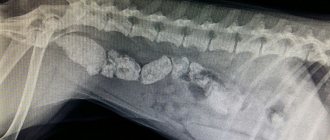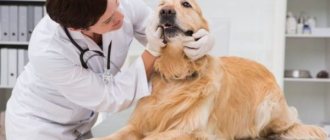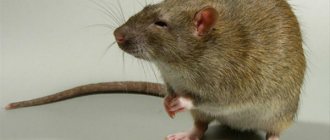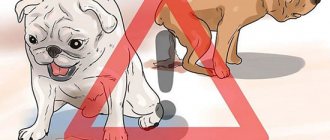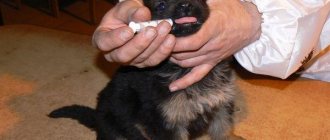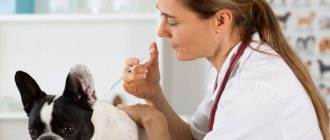Characteristics and danger of injuries from a dog bite
A wound left on the body by an animal, according to the ICD-10 list, is prescribed by code W 54: Bite or blow inflicted by a dog.
The jaw of a predator is designed in such a way that, when closed, the upper and lower jaws tear off whole pieces from the prey. As a result, blood vessels, tendons, and nerves can be torn. When bitten by large individuals, bones are often broken. In 15–20% of cases, injuries are complicated by infection. The first signs develop after 8–24 hours.
Based on the nature of the damage, the following are distinguished:
- torn. They occur when a dog’s teeth slide across the skin and apply pressure at the same time. Severe wounds with jagged edges remain on the body. May be accompanied by large loss of blood. Most often, such injuries remain on the hips, ankles, forearms, and palms. In young children, the head and neck area may be affected. With open, depressed skull fractures, the risk of death is high;
- chopped. The wound goes deep, there are no soft tissue ruptures. Bleeding begins at the site of exposure to teeth and fangs, which is quickly stopped by treatment with medications and applying a bandage.
Therapeutic tactics depend on the type of injury.
Types of bites
Externally, a dog bite, as well as a wolf bite, resembles a laceration or puncture wound. The fact is that the teeth of these animals are quite sharp. A fight with any representatives of predators can turn into a tragedy for a person. Experts distinguish two main types of bites.
- Superficial bites. They are characterized by the absence of bleeding and occur when the animal does not close its mouth completely, but only slightly damages the skin. Superficial bites are not life-threatening, but it is still not recommended to neglect contacting a specialized institution. It is better to make sure that nothing really threatens your health than to think that nothing terrible has happened and put yourself at risk.
- Deep bites. The most dangerous to health and can even pose a threat to human life. Deep bites are characterized by severe bleeding, soft tissue damage, swelling and shock. If a dog bites until it bleeds, pain may persist for several hours. People most often receive such injuries from stray dogs. Often, homeless animals gather in packs and attack due to hunger, or due to forced defense. A deep bite can also be obtained from a domestic dog. Such cases are not uncommon. An animal can cause serious injury even to its beloved owner due to fright or as a result of infection with rabies.
If you are bitten by a domestic dog, you must take exactly the same measures as in the case of a street dog.
Deep dog bite
The body's reaction to a dog bite
When an animal attacks, the jaws exert strong pressure on the skin. Damage to the skin, muscles, tendons, and blood vessels is provoked. Immediately upon or after a bite, dangerous microbes that live in the mouth of every dog - domestic and stray - enter the body. First they land on damaged tissues, from where they spread throughout the circulatory system. If the immune system is weakened, then dangerous microorganisms overpower the natural mechanism and strike the entire body.
The following types of anaerobic bacteria cause wound infection after a dog attack:
- fusobacterium;
- corynebacteria;
- prevotella;
- Neisseria;
- capnocytophaga;
- staphylococcus;
- hemophilus;
- bacteroides;
- Eikenella;
- enterobacter;
- Klebsiella;
- streptococcus;
- Moraxella and others.
Infection of wounds after a dog bite is manifested by the following local reactions:
- discharge of whitish fluid;
- redness;
- edema;
- a reddish rash along the edge of the damaged area.
The victim may complain of increased body temperature, fever, and a significant increase in lymph nodes.
Consequences of injury
A sick animal is not always identified by its symptoms. In some cases, the virus remains inside the body without symptoms for 10 days. The incubation period is variable - from 7 days to 12 months. Even domestic dogs can get rabies from a wild animal, so they need timely vaccination.
- Within 4 days after the introduction of the virus, there is an increase in temperature and loss of appetite. The condition is accompanied by headache. In the wound where the infection has entered, the tissues pulsate. Sensitivity increases from touch.
Within 4 days after the introduction of the virus, there is an increase in temperature and loss of appetite. - The virus excites the nervous system, causing movement disorders. This can be fussiness, which as it progresses turns into severe anxiety and aggression. Convulsive state, paralysis, delusional speech and visions are noted. Light and noise irritate and become unbearable to perceive. Body temperature reaches 40 degrees.
- Paralysis of the eyes develops, the swallowing function is impaired, which provokes the release of foam from the oral cavity. An infected person is afraid of water, and degeneration of cranial nerves occurs. Impaired respiratory function causes clinical and then biological death. With the rabies virus, they die within 15-60 days.
First aid for a dog bite
If the bleeding is moderate, do not rush to stop it. The blood coming out of the wound removes the animal's saliva along with germs.
If there is a large area of damage or heavy bleeding, it is necessary to urgently call an ambulance. Before the doctors arrive, you can take the following actions:
- Wash the bite area thoroughly with plenty of running water and soap. If you have boiled water in the house, it is better to use it for treatment, diluting it with hydrogen peroxide to wash away the dog’s saliva.
- Apply an antiseptic to the wound - a weak solution of furatsilin, potassium permanganate or peroxide. The area around can be lubricated with brilliant green or iodine. Avoid contact with injured tissue.
- Cover with cotton wool and a sterile bandage, applying light pressure.
Applying a tourniquet over the bite will help stop excessive blood loss.
After providing first aid, wait for emergency doctors or go to the nearest emergency room. A surgeon or traumatologist will examine the injury, clean it, and remove severely injured or dead tissue if necessary. A wound bitten by a dog, code according to ICD 10/W54, can be sutured if there is confidence in the absence of infection, no later than after 12 hours. If infection is suspected, suturing is performed after 3–5 days. The operation is performed by a surgeon taking into account the characteristics of the injury.
How to protect yourself?
At the moment, there is no effective treatment for rabies in the world. The only way to prevent the development of the disease is prevention. Non-specific prevention of social significance includes eliminating the source of infection and catching dogs. Pets need to have up-to-date vaccinations.
What to do if a dog bites you on the street, and its behavior was alarming and inappropriate? In this case, you need to immediately call an ambulance and adhere to the vaccination schedule.
How to treat a wound
If there is slight bleeding after a dog bite, it is enough to wash the wound area well with soap and water. When inflammation or bruising occurs, cold is applied.
If the wound is open and bleeding is coming from it, follow the first aid algorithm and use the following drugs as antiseptics:
- ethyl alcohol 70%;
- Miramistin;
- Batadin;
- hydrogen peroxide;
- Chlorhexidine.
A bandage is required. A sterile bandage, gauze pad or clean cotton cloth will do.
Ointments should not be used for the initial treatment of bite wounds.
What to do if bitten by a rabid dog?
- They bleed so that the infection does not get deep into the tissue. For a small wound, an additional incision is made.
- The bite site is thoroughly washed with water and laundry soap, then antiseptic preparations are used.
- The wound is covered with a sterile bandage, but maintaining blood circulation.
The wound is covered with a sterile bandage, but maintaining blood circulation. - Call an ambulance for further qualified assistance.
Further treatment tactics
To prevent infection of the body, according to the doctor's decision, antibiotics are prescribed. Their action is aimed at suppressing the activity of bacteria present in the dog’s saliva.
Some specialists use antibiotic therapy to prevent secondary infection, others prescribe only for wounds from bites that pose a particular risk (deep, inflamed, begin to fester, if localized, on the face, hands). Antibiotics are required even for minor injuries in people with diabetes, AIDS, after removal of the spleen, or a course of chemotherapy.
Amoxicillin-clavulonic acid, tetracyclines, and quinolones meet the criteria for therapeutic effectiveness.
When seeking medical care, the patient will be offered a rabies injection. The injection has no contraindications. Allowed during pregnancy.
The composition contains immunoglobulin and auxiliary components. The first vaccination is carried out on the day of treatment. The course consists of 7 injections in total. The rest are placed strictly on the dates prescribed by the attending physician. The injection is given at the site of the bite wound and into the shoulder.
If the dog is domestic and has been vaccinated, the person who was bitten may not be vaccinated. If the animal's vaccination status is unknown, veterinary observation is carried out. The dog is alive and well, which means vaccine treatment is not required. If rabies is suspected or the animal has died, the victim must undergo a course of injections.
Tetanus prophylaxis is mandatory.
Important facts
- Human infection occurs through a bite; 99% of all cases occur in dogs.
- The development of the virus can be prevented through vaccinations.
- More than half of all bitten patients are children under 15 years of age.
- With immediate first aid in the form of washing the wound, the chances of survival increase.
The development of the virus can be prevented through vaccinations.
The virus enters through a deep bite or scratch caused by an animal. The route of transmission is mucous membrane or blood. Infection of a person from another person was not observed, as was the case with the consumption of processed livestock meat. The rate of transmission of the virus depends on the location of the bite, its depth and the amount of saliva produced by the animal. The most dangerous are wounds with torn edges in the head and hands.
Rabies is not transmitted unless the saliva of a sick dog gets into a wound. There is also no threat of infection when the bite through clothing did not damage the tissue and there was no contact with the body. An animal vaccinated against rabies within a year will not be a carrier of the disease. However, he must have no symptoms. Urine, excrement and blood do not contain the virus; it persists only on mucous membranes and in saliva.
Folk remedies for treatment and their effectiveness
After being examined by a doctor and taking the necessary measures, the patient continues to treat the wound after a dog bite at home. The victims remain in the hospital with extensive injuries, rupture of muscles, tendons, arteries, and broken bones. To speed up the healing process, many resort to traditional medicine recipes. Their effectiveness has been proven for decades.
- Rinse the injury with saline solution. Method of preparation: for 1 liter of boiled warm water there is 1 tbsp. l. salt.
- Compress with aloe juice. Squeeze liquid out of the leaves of the plant, soak gauze, apply to the sore spot, change as it dries.
- Washing with propolis. Dilute the bee medicine tincture with water in a 1:1 ratio and process regularly.
- Clove infusion. Steam dried clove buds with boiling water and leave to cook for 90 minutes. Drink three times a day before meals. The product helps the skin heal faster and kills infection.
- Medicinal nettle. Grind the herb into fine powder, mix with a small amount of salt, and apply to the wound.
- Garlic therapy. Eat 5-10 cloves daily, regardless of meals. The method helps to disinfect the body and stimulate protective functions.
Use prescriptions only with your doctor's permission. It is important that the patient's condition is satisfactory. The use of natural remedies is not a replacement for antibiotics or medicinal ointments.
Causes of aggression in dogs
A dog's behavior changes due to infection. Once infected, the pet ceases to be interested in the world around it. Lethargy and depression are noticeable in gait and behavior. An affable and friendly dog, for some reason unknown to its owner, seeks to retire to a dark place.
Sometimes animals show unusual affection, constantly lick their hands and show increased attention to humans. Breathing becomes heavier, shortness of breath appears. In some cases, there are no previous symptoms, and the stage of the disease immediately begins with paralysis and convulsions.
A dog's behavior changes due to infection.
The dog licks the bite site and chews out the fur. The animal eats inedible objects, such as earth and wood. Swallowing is impaired, and the pet refuses to drink and eat for several days. Drooling and foam come from the mouth, which is caused by paralysis of the jaw. After violent attacks, apathy and drowsiness sets in.
The pet's aggression is caused by neurological disorders, and weight loss is noted. After the active spread of infection in the brain, coordination of movement is completely disrupted. At the sound of water, the dog panics and soon dies from the rabies virus.
The principle of aggressiveness in the disease has not been fully studied, but scientists were able to determine the action of the pathogen at the cellular level. The simple genetic code of the virus destroys behavioral reflexes and only affects brain activity.
Bleeding
Any bite that breaks the integrity of the skin is accompanied by bleeding. Because dogs have very sharp teeth, the bite can be deep enough to damage important arteries. Capillary bleeding is the most insignificant; venous and arterial bleeding pose a danger.
Arteries are located in tissues close to bones. Arterial bleeding occurs with a deep bite. Blood in the arteries flows under strong pressure, so bleeding from the arteries is dangerous due to excessive blood loss in a short period of time. The arteries are enclosed in a muscular layer and have the ability to contract. Thanks to this, arterial bleeding can stop on its own.
Venous bleeding is more common than arterial bleeding, since the veins are located closer to the skin. When a vein is damaged, blood flows continuously and abundantly.
Answer
A dog bite is a frequent and dangerous injury that provokes a number of serious complications, including a list of infectious diseases, leading to rabies. Often a bite is provoked by human behavior, for example, when attempts are made to separate fighting dogs. Men are more often bitten than women.
If an injury is sustained, severe pain occurs and acute inflammation develops. Sometimes the bite site becomes suppurated. Pus has an unpleasant, pungent odor. The infection may spread to bone tissue and joints, causing osteomyelitis.
Treatment of a dog bite is a complex and multi-stage process that requires an integrated approach and supervision by a surgeon, infectious disease specialist and dermatologist. Often dog bites present as a laceration, and a little less often as a puncture wound.
As a rule, an attacking dog never makes eye contact with a person. Do not try to interfere when the dog is eating, fighting, or mating. Do not allow your animal to lick open wounds.
What will they do at the emergency room?
The doctor will examine and treat wounds, examine bones and joints, and, if necessary, do x-rays and ultrasound. And, of course, he will deal with the prevention of rabies and tetanus.
It is impossible to receive such a volume of assistance in other medical institutions.
When and how are rabies vaccinations given?
Rabies vaccinations are given to everyone who is bitten. Always. Just in case. A few injections are nothing compared to death from rabies.
The first injection is given immediately. The next ones are strictly on schedule on the 3rd, 7th, 14th, 30th and 90th day after the injury. The full course includes six vaccinations. But if the dog does not get sick 10 days after the attack, you can limit yourself to three injections.
Forget about 40 shots in the stomach. They haven't made them for 20 years.
New vaccines are now being used that have no contraindications. The vaccine is administered according to the same scheme to children, pregnant women, and other adults. For adults - in the shoulder, and for children - in the thigh.
Rabies vaccinations are free. They are done on weekends and holidays.
When and how are tetanus vaccinations given?
Tetanus pathogens enter the wound along with dirt. 80% of those infected die. That's why we all get tetanus vaccinations as children, and then repeat them every 10 years. At least they should.
It is advisable to bring your medical documents to the emergency room or remember when and how many vaccinations you received. The doctor's decision about vaccination will depend on the severity of the wounds, their contamination, and the number of previous vaccinations.

